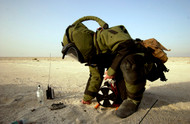Adapting to the Evolving Threat: Trends in Improvised Explosive Devices and Strategies for Bomb Technicians
Posted by Jeremy Stafford on Mar 11th 2024
In the ever-evolving landscape of global security, bomb technicians (bombtechs) face an increasingly complex array of threats due to the use of improvised explosive devices (IEDs). These devices, often fashioned from everyday materials, present unique challenges due to their varied designs, deployment methods, and triggers. This blog article delves into the current trends of IEDs, exploring their implications for bombtechs and the strategies employed to mitigate these threats.
1. Complexity and Innovation
The innovation in IED design is a significant trend, with terrorists and hostile actors continuously seeking new methods to evade detection and maximize damage. Modern IEDs incorporate sophisticated triggering mechanisms, including remote activation via cell phones, infrared signals, or wireless networks. This complexity requires bombtechs to possess a deep understanding of electronics, engineering, and the tactics employed by adversaries.
2. Utilization of Commercial Drones
A concerning trend is the adaptation of commercial drone technology for deploying IEDs. Drones can carry explosive payloads to specific targets, bypassing conventional security measures. This method represents a shift towards airborne threats, requiring bombtechs to consider aerial interception techniques and electronic countermeasures to neutralize drones before they can deliver their payloads.
3. Chemical and Biological Components
There's an increasing use of chemical and biological components in IEDs, aimed at causing widespread panic, contamination, and complicating the response efforts. This trend necessitates bombtechs to have specialized training in hazardous materials handling, chemical detection equipment, and decontamination procedures, alongside their explosive ordnance disposal (EOD) expertise.
4. Internet and Social Media as Knowledge Sources
The internet and social media platforms have become significant sources for the dissemination of IED construction techniques. This accessibility of information has democratized the knowledge required to build sophisticated explosive devices, expanding the threat beyond organized terrorist groups to include lone actors. Bombtechs must now keep pace with the information available online and adapt their countermeasures accordingly.
5. Counter-IED Technologies and Strategies
In response to these trends, bombtechs and their supporting organizations invest heavily in counter-IED technologies, including advanced robotics, x-ray imaging, and bomb disposal suits that offer greater protection and mobility. Training scenarios have also evolved, incorporating virtual reality simulations that cover a broader spectrum of IED threats.
6. International Collaboration and Information Sharing
Given the transnational nature of IED threats, there is a growing emphasis on international collaboration and information sharing among bomb disposal units. Joint exercises, shared databases of device fingerprints, and cooperative research into new EOD technologies enhance the global community's ability to respond to IED incidents.
Conclusion
The landscape of IED threats is dynamic, with bombtechs at the forefront of adapting to new challenges. Their role demands not only technical skill and bravery but also a continuous commitment to learning and innovation. As the nature of threats evolves, so too will the strategies and technologies employed to safeguard lives and infrastructure. The resilience and ingenuity of bombtechs remain vital in mitigating the impact of these insidious weapons.

